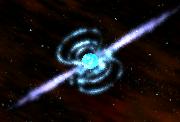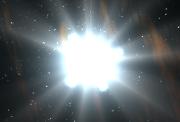Imagine the Universe News - 11 September 2000
Astronomers Find the Youngest Pulsar Yet
| 11 September 2000 |
Astronomers at Columbia University used the Rossi X-ray Timing Explorer to find the youngest pulsar yet -- a hot, spinning, highly-magnetized infant no more than ten miles across, born in a massive star explosion about 700 years ago.
 |
 |
| High-resolution TIF image (3.9 Meg) | High-resolution TIF image (4.9 Meg) |
Other known pulsars, in comparison, are thousands to millions of years old. This pulsar, in the supernova remnant Kes 75, is about 300 years younger than the Crab pulsar, which used to be the youngest known. And this baby is full of surprises too.
Scientists have long considered the Crab to be the archetypal young pulsar. Yet, compared to the Crab, the Kes 75 pulsar spins ten times more slowly; it is slowing down at a rate ten times faster; and it has a magnetic field that is ten times greater -- all unexpected findings that may cause scientists to rethink the birth properties and evolution of pulsars.
"People have been searching for this pulsar for years," said Dr. Eric Gotthelf, the Columbia astronomer who spotted the pulsar with NASA's Rossi X-ray Timing Explorer (RXTE). "We have seen bright radio waves in the core of Kes 75, telltale evidence for a pulsar. The problem was that we were expecting to find a rapidly spinning 'Crab-like' pulsar. What we found instead is quite different from our expectations."
A pulsar is a type of neutron star, the core remains of a giant star that was once at least ten times more massive than the sun. Such a star, upon depleting all of its nuclear fuel, explodes, ejecting most of its outer shell and leaving only a core, which collapses upon itself to form a hot ember about 10 miles in diameter. The ejected material forms a beautiful supernova remnant of colorful gas, visible for several millennia in visible light and at X-ray and radio wavelengths.
Pulsars have strong magnetic fields that channel electrons along the magnetic field lines away from the pulsar's polar regions. These electrons, accelerated to nearly the speed of light, radiate at the poles, particularly as radio waves, X rays and gamma-rays. Astronomers see pulsars "pulse" on and off as the beams of radiation from the rotating pulsar sweep across the Earth, like a beam from a lighthouse.
Locating the pulsar associated with a given supernova remnant is not so straightforward. When the star explodes, the shock might kick the resulting pulsar away from the site of the explosion. Other times, the pulsar's beams of light might not sweep past the direction of the Earth, so it is never seen. Or, as is suspected in recent 1987a supernova, the stellar core might collapse into a black hole.
"This pulsar is located right in the center of the supernova shell," said Gotthelf. "We only see this for a few other pulsars. So, the Kes 75 pulsar provides rather strong observational evidence that the neutron star is born in the stellar explosion that gives rise to the supernova remnant shell."
X-ray data reveals that the Kes 75 pulsar spins upon its axis once every 0.3 second, which is slow for young pulsars but fast compared to older ones. The pulsar's age is 700 years, consistent with the age of the supernova remnant that houses it.
The Kes 75 pulsar is also at least 10 times more magnetic than ordinary pulsars but about 10 times weaker than magnetars, a mysterious, newly identified class of highly magnetized objects. The Kes 75 pulsar may therefore be a missing link between these classes of objects. The pulsar's magnetic field is 100 trillion times that of the Earth's and would distort compass readings a half million miles away. Such a strong magnetic force is actually rapidly slowing down the spin of the pulsar.
Younger, highly magnetized, rapidly spinning pulsars provide astronomers with a wealth of information about this strange class of objects, first discovered only 33 years ago. Young pulsars are prone to starquakes, which changes the spin rate and reveals clues to their internal structure. Monitoring their change in spin rate allows astronomers to measure the rotational energy loss and compare it to the observed radiation. This provides a powerful probe of this central engine powering bright radio cores of supernova remnants.
Gotthelf found the newly born pulsar, now named PSR J1846-0258, through a deep observation with RXTE of the area around Kes 75 lasting nearly three hours. He narrowed his search to a central region within the Kes 75 supernova remnant using archived X-ray data from another satellite, the Japan-US Advanced Satellite for Cosmology and Astrophysics. The pulsar is about 60,000 light years from Earth on the far side of the Milky Way galaxy.
The Rossi X-ray Timing Explorer is a resourceful X-ray telescope with a large photon collecting area and ability to measure millisecond fluctuations in X-ray signals. This makes it a prime and unique instrument to detect and study rapidly spinning objects -- pulsars, neutron stars and black holes.
Assisting Gotthelf with the pulsar find were Dr. Gautam Vasisht (Jet Propulsion Laboratory), Michael Boylan-Kolchin (Columbia), and Dr. K. Torii (Tsukuba Space Center).

